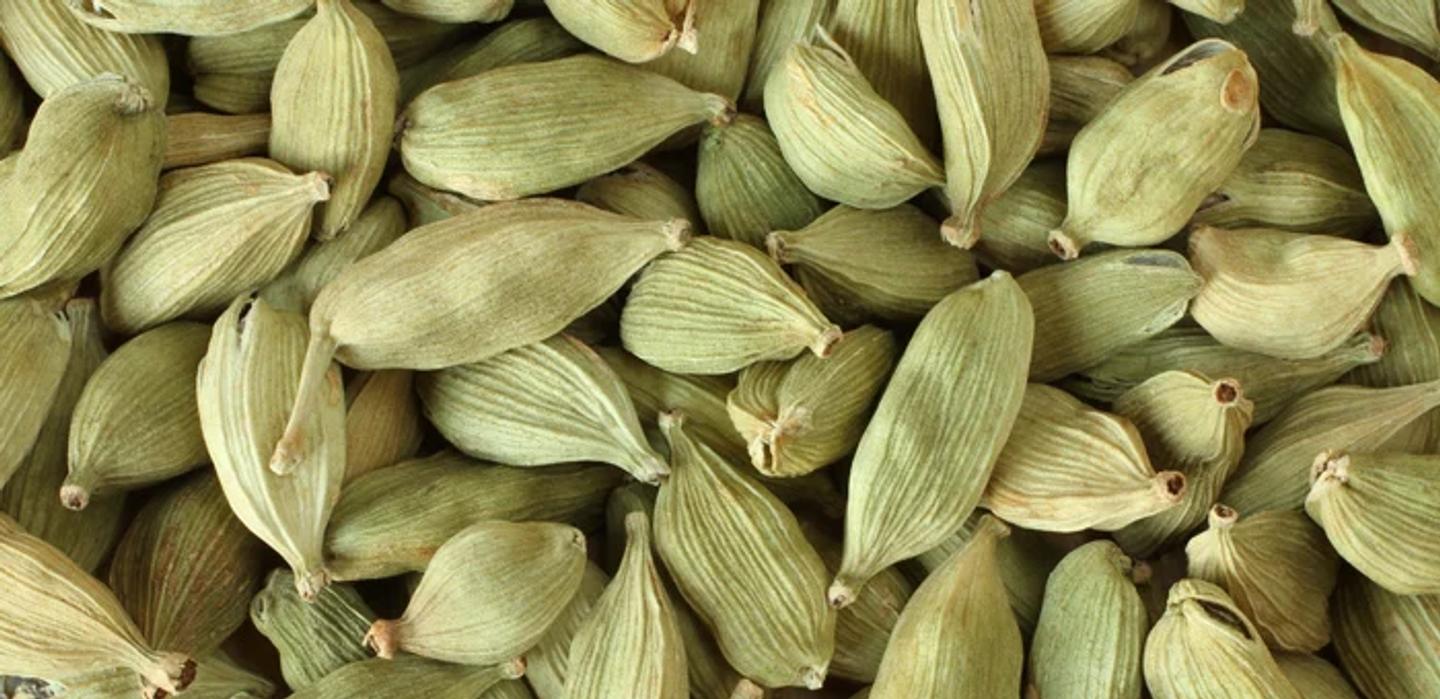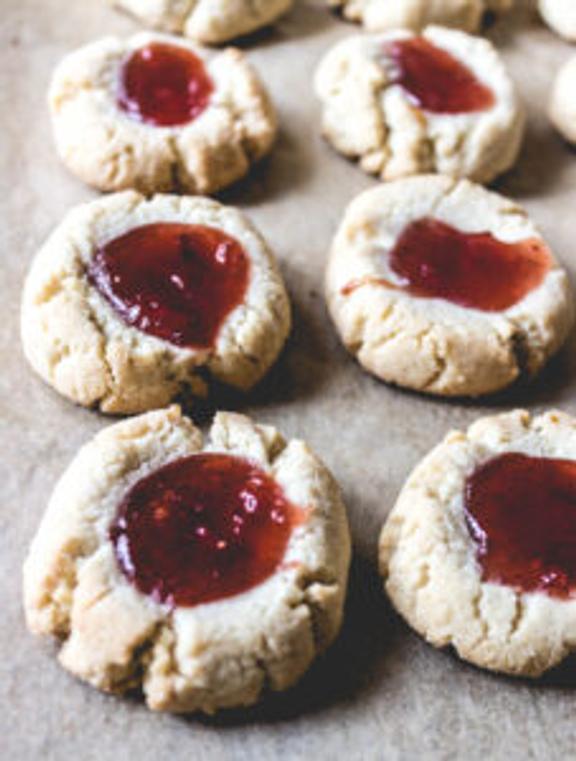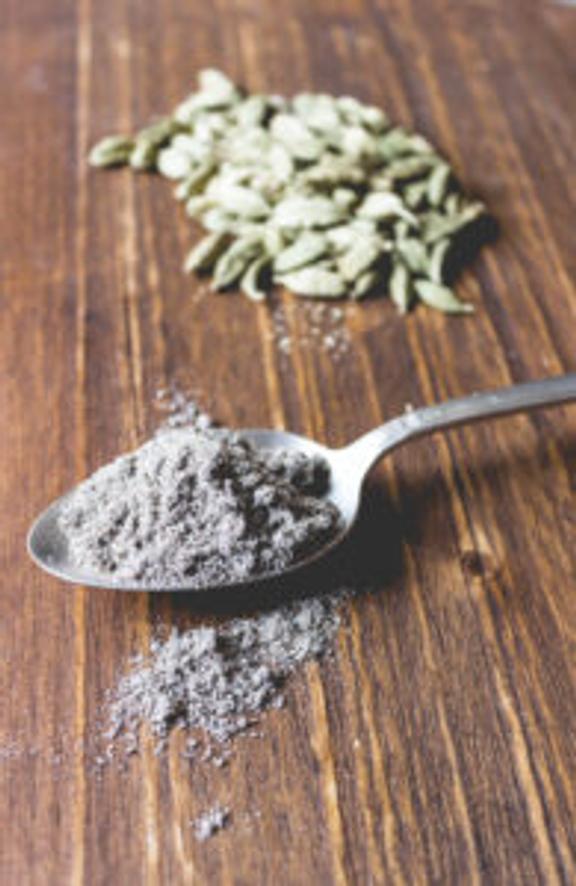
Cardamom (and cookies!)
BY: Andrea Nakayama
DATE: 2019-12-23
Holidays are often a time of “straying into the bike lane” as I call it. This means eating foods that aren’t generally on my menu, but also will not cause any symptoms that take me away from the gatherings and festivities.
“Bike lane” foods are those that I can have sometimes. And, as you can imagine, holidays can present many of those sometimes opportunities!
The good news is that not every sweet indulgence has to stray from your optimal diet, even if your daily food intake is a bit off the beaten path (mine is!) In fact, I have a perfectly sized (and healthy!) seasonal prize for you today—cardamom thumbprint cookies.
First let’s talk cardamom…
Although not as common in kitchens here in the U.S., cardamom is an everyday spice in many corners of the world, including India and the Middle East, where it’s revered for both its culinary flavor and medicinal properties.
Cardamom is composed of a small pod with black seeds inside. Both the seeds and the pod share the same distinct aroma and taste that’s a bit hard to describe.
Is it citrusy, woodsy, lemony, peppery, spicy, sweet, or some combination of them all? (Perhaps only your nose knows what it smells and tastes like to you!)
You might find a few different forms of cardamom if you sleuth around your local spice shop or ethnic market. The small and light green pods are called Elettaria and often called true cardamom while the larger pods are referred to as Amomum and may be black, white or red.
Either type of cardamom is excellent and I encourage you to try them all.
Interestingly, cardamom is from the same family of plants as ginger (Zingiberaceae) which may be why the two taste so terrific together and share many of the same medicinal qualities.
While the taste alone is enough for me to include more cardamom in my menu, it’s also a super spice when it comes to its medicinal properties, making it a favorite in both Ayurvedic and traditional Chinese medicines.
The most common use of cardamom is as a remedy for gastrointestinal disorders. Clinical trials have shown that the volatile oil present in cardamom (called methanolic extract) helps reduce flatulence, ease stomach cramps and supports proper digestion. Much like its plant partner, ginger, cardamom can also help combat nausea, heartburn, bloating, and loss of appetite.
Throughout history, cardamom has been utilized for its infection-fighting properties. Clinical trials now support this ancient wisdom with research showing that the volatile extracts contain antimicrobial properties that can inhibit the growth of microbes that often cause food poisoning, in addition to pathogenic viruses, bacteria, fungus and mold.
Similar to turmeric, cardamom is known to be anti-inflammatory. This makes it a powerful partner to help decrease inflammation and reduce pain and swelling, especially in mucus membranes and the throat.
If those reasons aren’t enough, know that cardamom is rich in various vitamins and micronutrients, especially manganese which plays a role in bone strength, healthy skin, balanced blood sugar and blood pressure. It also packs a punch with B-vitamins, Vitamin A, Vitamin C, sodium, potassium, calcium, copper, iron, magnesium, phosphorus, and zinc.
Just like some of our other favorite spices, you may get a bit zesty in the bedroom with a sprinkle of this condiment too. Cardamom has long been accepted as an aphrodisiac and was once even considered as a cure for impotence.
Cookies anyone?
Cardamom Thumbprint Cookies

Thumbprint cookies are a holiday favorite, and festive looking to boot. This recipe is so simple, the little ones in your life (little people or little thumbs) can easily help from start to finish.
Ingredients
2 ½ cups almond flour
½ tsp baking soda
¼ tsp sea salt
½ tsp ground cardamom
¼ cup melted coconut oil
3 Tbsp organic maple syrup
1 tsp vanilla extract
1 Tbsp gelatin powder (Great Lakes red label)
3 Tbsp hot water
unsweetened or fruit-sweetened fruit preserves or jam (red is jolly!)
Preparation
Preheat oven to 375 degrees F. Combine dry ingredients in a medium bowl. Heat 3 tablespoons of hot water in a small saucepan. Once it begins to steam, sprinkle gelatin powder over top. Turn off heat. Allow gelatin to sit and “bloom.” Then whisk briskly until foamy and dissolved.
Add coconut oil, maple syrup, and vanilla extract to gelatin and whisk to combine. Add wet ingredients to dry ingredients and mix thoroughly, until dough forms.
Line a cookie sheet with parchment paper. Roll a small amount of dough in your hands to make a 1-½ inch ball. Repeat with remaining dough and place on cookie sheet.
Use your thumb to create a shallow well in the center of each dough ball and fill with ½ teaspoon of fruit preserves.
Bake 8-12 minutes, until edges are golden. Allow to cool slightly and enjoy!
This recipe makes about 20 cookies.
It’s hardly homework since it’s an assignment I think you’ll be eager to accept, but I hope you will take a bit of time to bake a batch of cardamom cookies. Maybe you can even take these aromatic treats with you to your favorite cozy spot as you relax with a good book or a quiet mind.
Let’s infuse our collective cookie plate with nourishing spices and a whole lot of love this season. And all around, give yourself a thumbs up with a thumbprint.

in the kitchen with cardamom
When buying fresh cardamom pods, they should be heavy and have a sweet aroma when rubbed. (Pass on the pods that feel light and have surface discoloration or spots.)
fresh ground cardamom should have a spicy, sweet, citrusy smell
make cardamom-infused tea by simmering whole cardamom pods, alone, with ginger, or to enhance any type of tea you like
cardamom compliments sweets and desserts and is a common addition in Indian-inspired treats (like our cookies)
add ground cardamom to savory dishes like meat stews, lentil dishes, rice-pilafs and curries
make cardamom your secret smoothie ingredient with a dash or two in it or on top
kheer or rice pudding often features cardamom paired with pistachio and raisins; play with that combination in treats of any kind
diffuse or inhale cardamom essential oil to ease digestive issues or improve alertness
Related Blog Posts
Functional Nutrition Tip – The truth about compliance
true, but partial
Part 1: What’s Functional and what’s not

By: Andrea Nakayama, FxNA Founder & Functional Medicine Nutritionist
Functional Nutrition Alliance provides the comprehensive online Functional Nutrition training in the Science & Art of the Functional Nutrition practice. Learn to address the roots of your clients’ suffering with client education, diet & lifestyle modifications.